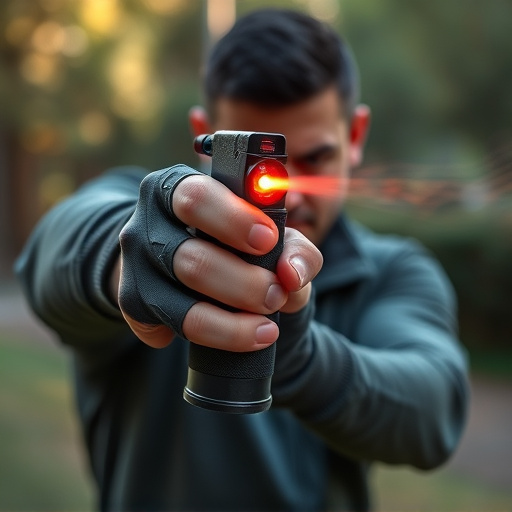Pepper spray, primarily made from capsaicin and its derivatives, is a powerful crowd control tool for law enforcement. These compounds induce a rapid burning sensation on mucous membranes, causing temporary blindness, breathing difficulties, and severe pain, aiding in dispersing large gatherings safely. The selection of the strongest legal pepper spray ingredients involves balancing effectiveness with regulatory guidelines, ensuring permissibility and safety without lasting harm. Effective usage requires rigorous training and education for officers to mitigate risks like respiratory issues and misuse.
In today’s diverse and often unpredictable social landscapes, effective crowd control tactics are paramount for law enforcement. One such tool, pepper spray, has evolved from a basic irritant to a sophisticated crowd control measure. This article delves into the science behind pepper spray’s effectiveness, explores legal considerations regarding strongest legal pepper spray ingredients, and underscores the importance of safe use, comprehensive training, and understanding potential risks associated with its deployment.
- Understanding Pepper Spray as a Crowd Control Measure
- The Science Behind Pepper Spray's Effectiveness
- Legal Considerations and Strongest Ingredients
- Safe Use, Training, and Potential Risks
Understanding Pepper Spray as a Crowd Control Measure
Pepper spray, officially known as oleoresin capsicum (OC) spray, is a crowd control measure used by law enforcement to disrupt and disperse large gatherings of people quickly and safely. It works by irritating the eyes, nose, throat, and lungs, temporarily disabling individuals and creating a buffer zone between police and protesters or rioters. Understanding the effectiveness of pepper spray lies in its active ingredients, which are among the strongest legal pepper spray components available.
The most potent legal pepper spray ingredients include capsaicin, the primary active compound found in chili peppers, and various derivatives designed to maximize potency while minimizing side effects. These chemicals create a burning sensation when they come into contact with mucous membranes, leading to temporary blindness, difficulty breathing, and intense pain. This swift and powerful reaction allows police to control chaotic situations, ensuring officer safety and minimizing harm to those involved.
The Science Behind Pepper Spray's Effectiveness
Pepper spray, formally known as oleoresin capsicum (OC) spray, is a crowd control agent that disrupts normal vision, breathing, and movement. Its effectiveness stems from its key ingredient—the strongest legal pepper spray ingredients are capsaicin and related compounds found in chili peppers. When sprayed onto the skin or eyes, these chemicals bind to pain receptors, triggering a burning sensation and causing the body to release neurotransmitters that affect the central nervous system. This reaction leads to temporary blindness, coughing, difficulty breathing, and extreme discomfort, making it an effective tool for law enforcement to manage large gatherings where de-escalation is crucial.
Research has shown that pepper spray can be particularly useful in situations where other non-lethal force options may not be as reliable or immediate. The potency of different pepper sprays varies based on the concentration of capsaicin, with higher concentrations providing longer durations of effect and greater distances of coverage. This variation allows law enforcement agencies to choose the most suitable product for specific needs, ensuring public safety while minimizing potential harm to both officers and civilians.
Legal Considerations and Strongest Ingredients
When it comes to pepper spray for crowd control, legal considerations play a crucial role in determining what ingredients can be used. Each jurisdiction has its own regulations and restrictions on the concentration and composition of pepper spray to ensure public safety and prevent excessive force. The strongest legal pepper spray ingredients are typically those that have been approved by these regulatory bodies, offering effective crowd control without causing long-term harm or disability.
Among the strongest legal pepper spray ingredients, capsaicin is a prominent compound derived from chili peppers. It’s widely used due to its high efficacy in disabling and disorienting individuals, making it a preferred choice for law enforcement agencies. Other active ingredients may include piperine, which enhances capsaicin’s potency, and various alkyl amines that contribute to the spray’s irritant properties. These ingredients are carefully formulated to meet legal standards, ensuring their use is permissible while providing effective crowd control measures.
Safe Use, Training, and Potential Risks
The safe use of pepper spray for crowd control requires thorough training and an understanding of its potential risks. Law enforcement agencies must ensure that officers are properly equipped with knowledge about the spray’s active ingredients, such as the strongest legal pepper spray components, to minimize harm to both the public and themselves.
Training programs should cover correct application techniques, safe distances, and de-escalation strategies. Officers must be prepared for unexpected reactions, especially in diverse crowd settings. While pepper spray can effectively disrupt and disperse crowds, it poses risks like respiratory irritation, temporary blindness, and potential misuse or abuse, which necessitates ongoing education and supervision to mitigate these dangers.
Pepper spray has established itself as a valuable tool in crowd control, but its effectiveness and safe usage hinge on understanding its science and legal considerations. While the strongest legal pepper spray ingredients offer significant deterrence, they must be employed with proper training to mitigate risks. Striking a balance between public safety and responsible use is paramount, ensuring that pepper spray remains an effective yet controlled measure for crowd control in various scenarios.
